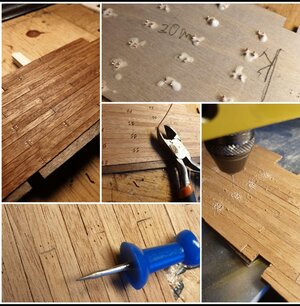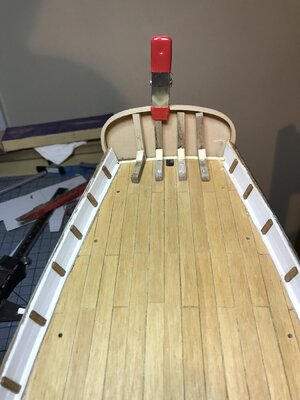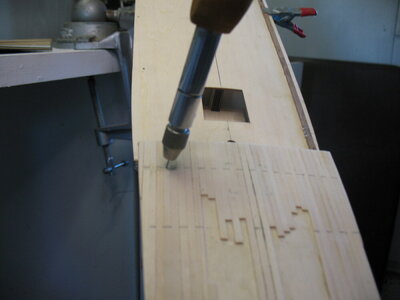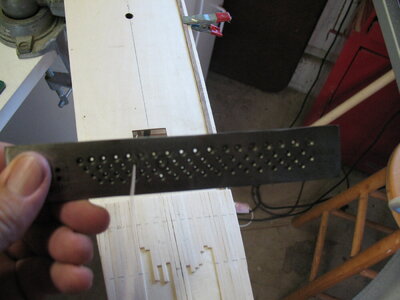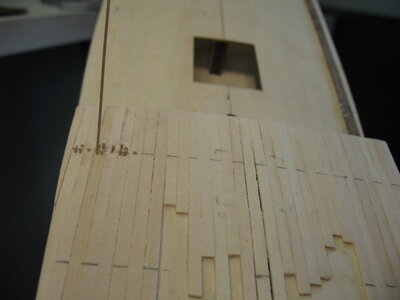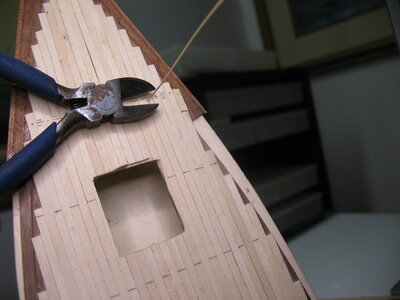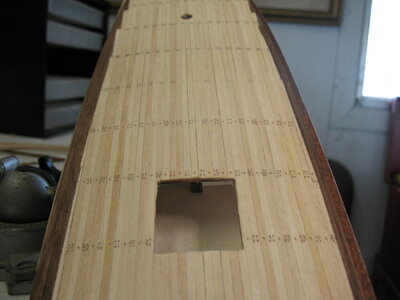I'm about ready to start the decking on my San Francisco model. My questions are: do you typically darken the edges of the deck boards before placing (to simulate caulking) ? And do you tend to add the nails with a pen to the decking? Thanks for your help!
You are using an out of date browser. It may not display this or other websites correctly.
You should upgrade or use an alternative browser.
You should upgrade or use an alternative browser.
Hello Philski, Imitating caulking and treenails is just a matter of personal preference and taste. It greatly depends on the scale of your model, for smaller scales it would be challenging to represent the correct size for both: caulking and treenails. To answer your question, yes, I do darken the edges with a soft pencil 2B before gluing them in position. For 1:48 scale I made my own wooden treenails, for the smaller-scale I use wood putty or simply just drill the hole.
Thanks! I've started darkening with a pencil on this build. Scale is 1:90Hello Philski, Imitating caulking and treenails is just a matter of personal preference and taste. It greatly depends on the scale of your model, for smaller scales it would be challenging to represent the correct size for both: caulking and treenails. To answer your question, yes, I do darken the edges with a soft pencil 2B before gluing them in position. For 1:48 scale I made my own wooden treenails, for the smaller-scale I use wood putty or simply just drill the hole.
I’ve seen several threads with using a pencil, thinned black acrylic paint, typically darken on one side of the plank only and one end. For nails, tree nails or simulation there are a few methods, drill small hole, sharp pencil, pin dipped in India ink and round birch toothpicks inserted into holes then trimmed off and sanded down, deck looks like a porcupine when doing it but the results are astounding. Check out this build Post in thread 'USS Bonhomme Richard 1779 1:48'
- Joined
- Apr 28, 2020
- Messages
- 112
- Points
- 88

When I was ready to deck my current Pride of Baltimore II build, I made a little fake deck to see what would look best. Being lazy, I thought that easy is good! I was happy to note that the bare planks,once stained,showed the seams just fine, so I went ahead and put on the deck,stained it, and added a couple of coats of polyurethane. I'm quite happy with the results.
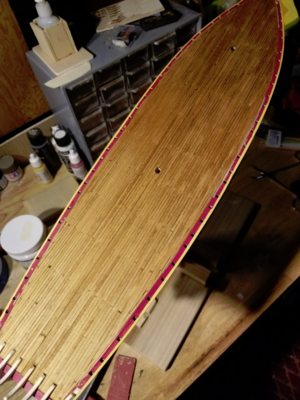
I didn't bother with simulating nails or using real tree nails. If I cared enough I would have just made dimples on the planks with a big needle and let the stain bring them out. Sometimes good enough is good enough.

I didn't bother with simulating nails or using real tree nails. If I cared enough I would have just made dimples on the planks with a big needle and let the stain bring them out. Sometimes good enough is good enough.
I use a black laundry marker pen (in the US available at the JoAnn's chain) and apply it along one plank edge. The color does not run if you later apply stain or varnish.I'm about ready to start the decking on my San Francisco model. My questions are: do you typically darken the edges of the deck boards before placing (to simulate caulking) ? And do you tend to add the nails with a pen to the decking? Thanks for your help!
I tried a permanent marker as a test to a scrap piece and this particular pen (Sanford Ultra Ine tip) really runs. I'll try some different methods to see what works. I'll get a laundry mark too.
Lots of good solutions for simulating caulking and nails.
I rarely darken edges or place tree nails or tree nail marks on my model ship decks for any scale less that 1/48. At the smaller scales these details just do not show well at scale and attempts to model caulking or tree nails are usually out of scale. But many do add these details and are happy with the results. I might consider these planking details on scale 1/48 builds. But even then, the natural unmarked seams of the planks are more to scale and tree nails would be too small to model effectively. Just my experience...my advice is to remember that for most at scale details smaller is usually more correct...
One more thought...I have walked the decks of a few period ships including the Constitution up in Boston Harbor and the deck boards looked like they had closely fitted edges...not necessarily a visible caulking between deck boards. Deck tree nails are all but invisible. So again...less is more...
One more thought...I have walked the decks of a few period ships including the Constitution up in Boston Harbor and the deck boards looked like they had closely fitted edges...not necessarily a visible caulking between deck boards. Deck tree nails are all but invisible. So again...less is more...
Last edited:
What I do for many of my decks is lay down the planking layer...most often bass wood...then, depending on the effect I want...use a stain. The stain seeps into the cracks and highlights the planking edges creating a nice “caulked” look. Then a coat or two of poly. Some of my decks I have actually painted a very light grey (not white...way too stark and bright) simulating a few years of salt water embedded into the wood from scrub downs turning the deck a whitish color. If you want to highlight deck seams may I suggest using a dark brown color rather than black. In my opinion, dark brown is more realistic, a more subtle contrast, and not as stark as black.
Last edited:
I’m working on a Pride of Baltimore build as well. I have visited her and have lots of photos. Her deck and deck furniture planking are virtually multi-colored—with individual planks ranging from reddish mahogany to light oak. Your pic looks like you have gotten some of that effect. How did you attain different hues on individual planksWhen I was ready to deck my current Pride of Baltimore II build, I made a little fake deck to see what would look best. Being lazy, I thought that easy is good! I was happy to note that the bare planks,once stained,showed the seams just fine, so I went ahead and put on the deck,stained it, and added a couple of coats of polyurethane. I'm quite happy with the results.
View attachment 204357
I didn't bother with simulating nails or using real tree nails. If I cared enough I would have just made dimples on the planks with a big needle and let the stain bring them out. Sometimes good enough is good enough.
- Joined
- Apr 28, 2020
- Messages
- 112
- Points
- 88

I didn't do anything in particular. The slight variations in the grain of the wood decking absorbed the stain differently. Consider staining a whole bunch of planks before you start planking. If glue gets on the raw wood it won't accept stain well.I’m working on a Pride of Baltimore build as well. I have visited her and have lots of photos. Her deck and deck furniture planking are virtually multi-colored—with individual planks ranging from reddish mahogany to light oak. Your pic looks like you have gotten some of that effect. How did you attain different hues on individual planks
Do you have a build log of your POB? Do you live in the Baltimore area? I'm in Frederick.
I got on board the ship under the shrink wrap while she was docked for COVID and was able to take some pictures. At the end of June, my wife and I will be sailing on her as guest crew members for a two overnight cruise. I'm not TOO excited!
I'll take your advice and stain the planks before gluing and use a couple of different color stains. I have not been doing a build log--I still work full time, and there would be just way too long a time between posts. I may upload the occasional picture if I think it might be of interest. I admire your commitment to sustain a log.
I live in Alexandria VA, so I am close enough to Baltimore to visit the POB. Man, I am envious or your opportunity to crew on her!
I live in Alexandria VA, so I am close enough to Baltimore to visit the POB. Man, I am envious or your opportunity to crew on her!
- Joined
- Apr 28, 2020
- Messages
- 112
- Points
- 88

Check out the POB website. They still may have guest crew slots available.
Will do. Thanks for the steer!Check out the POB website. They still may have guest crew slots available.
Just something to keep in mind - oil-based stains may cause issues with adhesives/glues. Try it in scrap pieces first.I'll take your advice and stain the planks before gluing and use a couple of different color stains. I have not been doing a build log--I still work full time, and there would be just way too long a time between posts. I may upload the occasional picture if I think it might be of interest. I admire your commitment to sustain a log.
I live in Alexandria VA, so I am close enough to Baltimore to visit the POB. Man, I am envious or your opportunity to crew on her!
Thanks. I will. Having walked it, I know the POB’s deck has never seen a holystone, and it really seems a nightmare to replicate in color or multicolor as it were.Just something to keep in mind - oil-based stains may cause issues with adhesives/glues. Try it in scrap pieces first.






